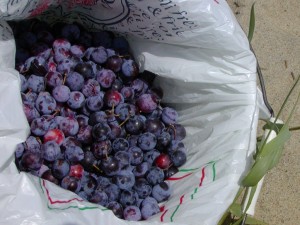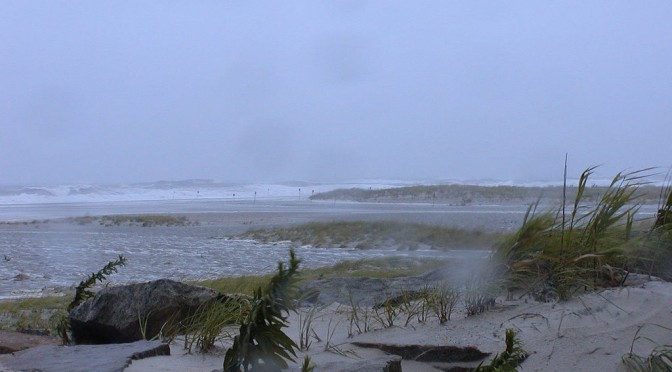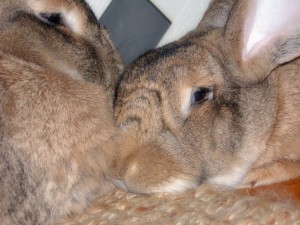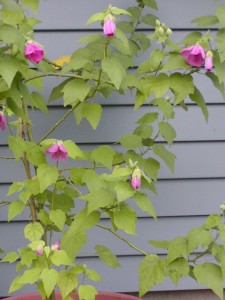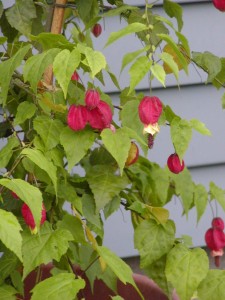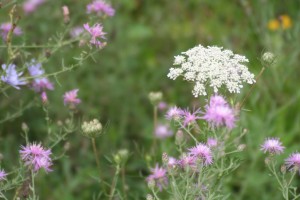 “September is the year at the turn, a young mother sending her children off to school and wondering if she can ever catch up with Summer tasks unfinished. It is Autumn at hand and Summer reluctant to leave; it is days loud with cicadas and nights loud with katydids; it is beets for pickling and pears for canning and apples for pies and sauce and cider. It is hot days and cool nights and hurricane and flood and deep hurt and high triumph.
“September is the year at the turn, a young mother sending her children off to school and wondering if she can ever catch up with Summer tasks unfinished. It is Autumn at hand and Summer reluctant to leave; it is days loud with cicadas and nights loud with katydids; it is beets for pickling and pears for canning and apples for pies and sauce and cider. It is hot days and cool nights and hurricane and flood and deep hurt and high triumph.
September is both more than a month and less, for it is almost a season in itself. It is flickers in restless flocks, readying for migration; it is goldfinches in thistledown; it is fledglings on the wing, and half-grown rabbits in the garden, and lambs in the feed lot. It is the gleam of goldenrod and the white and lavender and purple of fence row asters, with the bright spangle of bittersweet berries.
September is fog over the river valleys at dawn and the creep of early scarlet among the maples in the swamp. It is sumac in war paint. It is bronze of hillside grass gone to seed. It is walnuts ripening and squirrels busy among the hickories. It is late phlox like a flame in the garden, and zinnias in bold color, and chrysanthemums budding. It is a last gallant flaunt of portulaca and petunias defying time and early frost.
September is the first tang of wood smoke and the smolder of burning leaves. It is bass and perch revitalized in the chilling waters of pond and stream. It is the hunter’s dog sniffing the air and quivering to be off to the underbrush. September is time hastening and days shortening, it is the long nights of Autumn closing in with their big stars and glinting moon. September is the wonder and fulfillment and the ever amazing promise of another Autumn.” – Hal Borland, Sundial of the Seasons
Plum crazy I
Not plumming at Sandy Hook
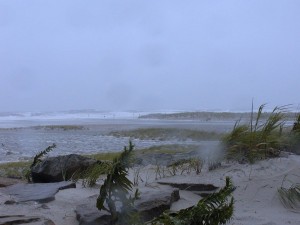 “Wild, wild the storm, and the sea high running,
“Wild, wild the storm, and the sea high running,Steady the roar of the gale, with incessant undertone muttering,
Shouts of demoniac laughter fitfully piercing and pealing,
Waves, air, midnight, their savagest trinity lashing,
Out in the shadows there milk-white combs careering,
On beachy slush and sand spirts of snow fierce slanting,
Where through the murk the easterly death-wind breasting,
Through cutting swirl and spray watchful and firm advancing,
(That in the distance! is that a wreck? is the red signal flaring?)
Slush and sand of the beach tireless till daylight wending,
Steadily, slowly, through hoarse roar never remitting,
Along the midnight edge by those milk-white combs careering,
A group of dim, weird forms, struggling, the night confronting,
That savage trinity warily watching.”
— Walt Whitman, Patroling Barnegat
My plan for this afternoon was to go out to Sandy Hook for a beach plum walk, but the weather didn’t cooperate. I still went and the NPS ranger was kind enough to give her speech about making beach plum jelly to just me (wonder why no one else showed up? lol!), but the planned walk to pick plums was cancelled due to the weather. We met at the Visitor’s Center which was a U.S. Life-Saving Station that rescued shipwreck victims during the 19th century.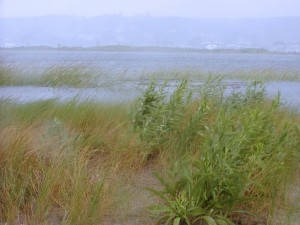
The ocean and marsh were still beautiful, but not walk-friendly despite my rain gear. I wasn’t the only nut out there – living close to the ocean makes it hard to resist going to see it all churned up with a storm. The saltmarsh at Plum Island was flooded and the only birds I saw was one wheeling group of shorebirds and a few Greater Black-Backed Gulls hunched down on a bit of high ground well out in the marsh.
The remnants of Ernesto are supposed to clear out overnight and I’m hopeful that tomorrow I’ll be able to pick some beach plums and try out the recipe the park ranger shared with me today.
Does it improve upon the silence?
 Can I rant a little about work? This will likely end up to be mean-spirited, so be warned.
Can I rant a little about work? This will likely end up to be mean-spirited, so be warned.
I’m generally a well-behaved person; not prone to complaining too much, but this has been bottled up most of the week and Deb, my best friend at work, is on vacation. I’ve been stewing without her ear to bend. I’ll use you guys as my sounding-board instead.
By the way, do you know Happy Bunny? I have a little collection spread around my cubicle at work. Deb thinks this is subversive on my part, but at least in my passive-aggressive way I’m letting my feelings be known to many of the people I work with. Most of them drive me nuts.
95% of the people I work with are women; that’s the first problem. Second of all, the vast majority of them seem to forever be going through menopause so my workplace is awash in unhappy hormones. Third of all, and worst; they all talk too damn much!
Another great quote I’ve recently added to my collection is this:
“Before you speak, ask yourself: is it kind, is it true, is it necessary, does it improve upon the silence?” – Shirdi Sai Baba
I’m going against that mantra now, but I’m fed up. I need quiet to work, to be productive. I come to work to work, not to socialize or as a replacement for a therapy session. Why is it any different for the people I work with? Deb and I go out to lunch or into her office with the door closed when we need to talk about personal things. Never mind that I don’t want the whole office to hear my personal business, but I respect them enough not to subject them to it! Why can’t others be as courteous?
Do I need to hear every detail of your most recent phone coversation with your out-of-state daughter, repeated ad infinitum for every one of your twelve friends who stop by your cubicle throughout the day? Can’t you at least change the story a little bit, for my benefit; your captive audience in the adjoining cubicle? Must I overhear every demeaning conversation you have with your husband? Do I need to know exactly and every single thing you plan to do this weekend? Do I need to listen to you alternate between cursing and crying every single day? Isn’t there some medicine you could take for that?
Some day, if I prove myself incompetent enough (I work for the government, after all) I might get promoted and have an office of my own, instead of a cubicle amidst this sea of moody women. Then I’ll be able to close the door on it all. Instead I’m forced to listen to this drather, day in and day out.
End of rant. Pretty pics and gentle-mannered nature observations to resume tomorrow. 😉
Trees in miniature – Deep Cut Gardens
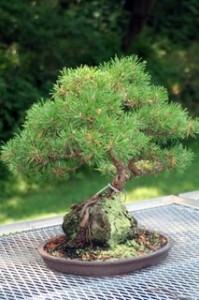 Delicate branches
Delicate branches
Roots caress a simple pot
White blossoms shimmer
The essence of all forests
Lives here in one small tree.
-Mastuyama Mokurai
The art of bonsai is meant to suggest a tree which has grown naturally under specific conditions, for example windswept on a rocky shore, clinging to the side of a cliff, or standing undisturbed in the forest. 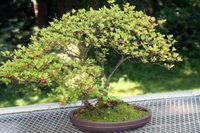 The time and patience needed to train a tree in miniature form to look natural and mature is, perhaps, the foremost challenge of this horticultural practice.
The time and patience needed to train a tree in miniature form to look natural and mature is, perhaps, the foremost challenge of this horticultural practice.
A gardener studying bonsai is encouraged to study nature and get out and look at trees. Get under them and look up. Notice them. Get to know them so that you might create a representation of all of nature in one small tree.
Pics taken in the Japanese Garden at Deep Cut Gardens in Middletown, NJ. Other posts about Deep Cut are available here and here.
Post submitted to The Festival of the Trees.
8/30/06 Mid-week bunny fix
Scrapbook samples
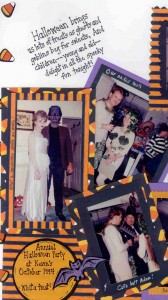 This is one of many pages done for my brother’s annual Halloween party. It was the first year after my DH and I were married, so we went as Frankenstein and his Bride. My DH makes a pretty convincing Frankenstein, doesn’t he? My brother and sister-in-law (in the strategically placed fig leaves) were Adam and Eve and my dad was a Keystone Cop. (This is a 14X14 page that wouldn’t fit on the scanner bed so it’s cut off on both ends.)
This is one of many pages done for my brother’s annual Halloween party. It was the first year after my DH and I were married, so we went as Frankenstein and his Bride. My DH makes a pretty convincing Frankenstein, doesn’t he? My brother and sister-in-law (in the strategically placed fig leaves) were Adam and Eve and my dad was a Keystone Cop. (This is a 14X14 page that wouldn’t fit on the scanner bed so it’s cut off on both ends.) First Christmas after we did some work on the house and got new furniture. Me with a Pixie haircut! (Another 14X14 page)
First Christmas after we did some work on the house and got new furniture. Me with a Pixie haircut! (Another 14X14 page)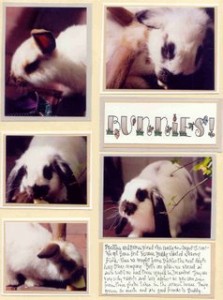 Missy and Freckles as little baby bunnies. Say “Awwww…”
Missy and Freckles as little baby bunnies. Say “Awwww…”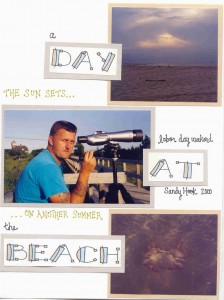 My husband seeing the osprey off at Sandy Hook on Labor Day 2000
My husband seeing the osprey off at Sandy Hook on Labor Day 2000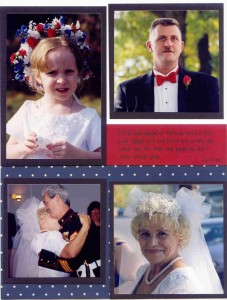 My brother-in-law’s wedding. I scrapbooked a wedding album as a gift for them.
My brother-in-law’s wedding. I scrapbooked a wedding album as a gift for them.Naturwoman and I have been chatting a bit on her blog about scrapbooking, and we each wanted to have a look at the other’s pages, so I thought I would share a few here tonight. These are scanned and should be clickable for a closer look, if you dare. What I like best about scrapbooking is the storytelling aspect; picking a few of the best photos from an event and using them to give a sense of what happened. I never used to be such a shutterbug, so the prospect of scrapbooking my photos seemed reasonable. Nowadays, the idea is pretty daunting.
Scrapbooking has evolved to be a very complex craft; I’m not artistic enough or patient enough to do the types of pages I see in magazines today. I like to use pretty papers and stickers and play with colors and different styles of handwriting. For the first few years I made my pages for a 14″ X 14″ album, then I switched to a more standard size. Now I like to do little *books* – smaller page sizes are more fun and a bit easier to do.
Now it’s your turn – let’s see some of those pages!
**Edited to add that Sandy at gardenpath has posted one of her pages – it’s really neat – have a look!
A waystation for migrant hummers
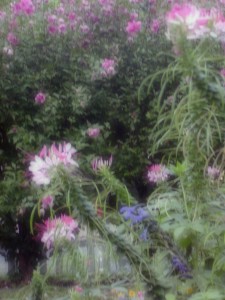 Colorful flowers attract hummingbirds to the garden; nectar makes them hang around for a while. I only see hummers in my garden in late July and August, so I try to plant late-blooming flowers that they like. They visit the cleome, but I’m not sure that they provide any nectar. They especially like the black-and-blue salvias and some other salvias that aren’t visible in this pic. I expect the hummers to arrive shortly after the Rose of Sharon hedge begins to bloom; again I’m not sure if they’re able to feed from the flowers, but they do visit them often and like to perch in the hedge in sight of the feeders.
Colorful flowers attract hummingbirds to the garden; nectar makes them hang around for a while. I only see hummers in my garden in late July and August, so I try to plant late-blooming flowers that they like. They visit the cleome, but I’m not sure that they provide any nectar. They especially like the black-and-blue salvias and some other salvias that aren’t visible in this pic. I expect the hummers to arrive shortly after the Rose of Sharon hedge begins to bloom; again I’m not sure if they’re able to feed from the flowers, but they do visit them often and like to perch in the hedge in sight of the feeders. 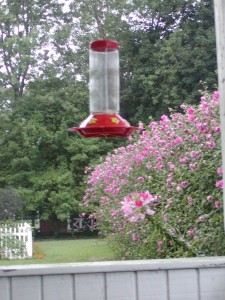 I place my feeders in as shady a location as possible so that the sugar-water won’t ferment as quickly. It’s important to maintain the feeder and change the solution at least every 2-3 days or anytime it looks cloudy. So as not to waste sugar, I only fill this feeder about a quarter of the way full – that’s more than enough for a day or two. Notice also that I don’t use red food coloring – it’s not needed so long as some part of the feeder is red to attract the birds.
I place my feeders in as shady a location as possible so that the sugar-water won’t ferment as quickly. It’s important to maintain the feeder and change the solution at least every 2-3 days or anytime it looks cloudy. So as not to waste sugar, I only fill this feeder about a quarter of the way full – that’s more than enough for a day or two. Notice also that I don’t use red food coloring – it’s not needed so long as some part of the feeder is red to attract the birds.
We have a variety of flowers that are pretty and attractive to hummers; flowering maples (Abutilon) are a favorite and come in many colors. My husband and I try to grow them all. 😉 We have them in purple, peach, yellow and red this year. The first hummingbird I ever saw was nectaring at a red blooming maple that we had trained as a small tree outside the bedroom window. These aren’t hardy for us in NJ, so we bring them inside each fall and try not to kill them. We usually fail.
Killing stuff over the winter gives us an excuse to try something new the following summer. This flowering maple is a new one for us – it looks like the hummers might like it, but I’m not sure about the lantern-shaped flowers. I also grow pineapple sage for the hummers, but it usually blooms so late for me that the hummers are long gone when it finally comes into flower.
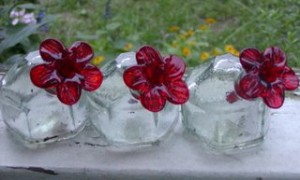
I have a collection of pretty glass hummingbird feeders like these that are really beautiful to look at, but are a nightmare to keep clean. My husband can’t resisit buying me a pretty new feeder each year for my birthday, but he’s not the one in charge of cleaning and filling them! I hardly ever use these ones because the ants always find them before anyone else.
Nothin’ like a Jersey tomato
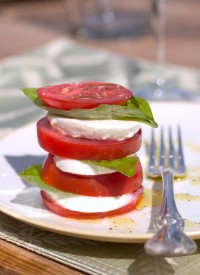
Is there anything sweeter than a Jersey tomato warm from the garden? Add just a little salt and pepper and you’ve served up perfection. My brothers and I used to eat them standing out in the garden, like an apple, when we were kids. Do NJ tomatoes have a reputation anywhere outside of NJ?
I never got around to cooking a proper Sunday dinner tonight; having spent most of the afternoon in front of the televison, which I almost never do. Instead I put together a salad of fresh mozzarella, basil from the garden, and heirloom tomatoes that I picked up yesterday at the farmer’s market. Just a drizzle of dressing made it perfect and delicious!
Michelle blogged today about tomato sandwiches (just add white bread, mayonaise, and salt+pepper) and Hanna at This Garden is Illegal has been blogging about fancy tomatoes for a week or so. It seems that many of us are rejoicing at the ripening of this good garden food. I’d love to hear your favorite way of eating a tomato. Share a recipe if you’d like. I have one that I’m eager to try – pasta, grape tomatoes, and goat cheese – sounds yummy!
Bird’s nest
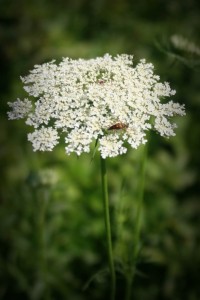 Bird’s nest is an alternate name for Queen Anne’s Lace, so called because of the way the stems rise upward to form a cup-shaped basket as the seed heads ripen, reminding some of a bird’s nest. The flower heads are flat-topped and as dainty as any fine lace; the foliage fine-cut and bright green. A single purple floret lies in the center of many, but not all, of the flowers.
Bird’s nest is an alternate name for Queen Anne’s Lace, so called because of the way the stems rise upward to form a cup-shaped basket as the seed heads ripen, reminding some of a bird’s nest. The flower heads are flat-topped and as dainty as any fine lace; the foliage fine-cut and bright green. A single purple floret lies in the center of many, but not all, of the flowers.
Some botanists believe that this central purple floret acts as decoy to attract insects to pollinate the flowers. It’s said that many insects will automatically be lured to the dark-colored flower and I’ve found crab spiders patiently waiting there for their next meal to arrive.
If the crab spiders have come recently from yellow flowers they will be light yellow and adorned with faint pink markings. After a few days on the white lacy flowers they gradually turn white, also with pink markings, to match perfectly the white “umbrellas” with their purple centers, near to where they are waiting for their next victims’ arrival.
These pics were taken in the meadow at Deep Cut Gardens, but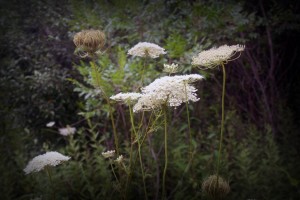 Queen Anne’s Lace can be found now along many a roadside. I’ll sometimes grow it in pots at home, afraid to set it loose in any of the gardens because it reseeds so freely. Queen Anne’s Lace has quite a few lookalikes, many of them deadly poisonous, so be very careful of sampling the root of any plant you suspect to be this wild carrot.
Queen Anne’s Lace can be found now along many a roadside. I’ll sometimes grow it in pots at home, afraid to set it loose in any of the gardens because it reseeds so freely. Queen Anne’s Lace has quite a few lookalikes, many of them deadly poisonous, so be very careful of sampling the root of any plant you suspect to be this wild carrot.
